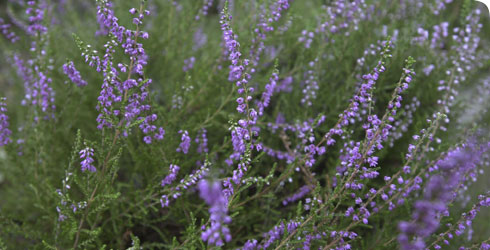Heathland
Heathland is a man-made habitat created by our ancestors thousands of years ago. It emerged where trees were cleared from areas with sandy, acidic and nutrient-poor soils in southern Britain. This created ideal growing conditions for plants such as heather and gorse. Resident animal species include basking reptiles, solitary wasps, and many species of butterfly and moth.
History
Since our native trees were first cleared, leaving heathland areas, the continual harvesting of plants, heather turfs and gorse for fuel, and bracken for animal bedding, has prevented any shrub and tree regeneration. Controlled grazing has the same effect. Without the shade of trees, heathland plants and other wildlife thrive in the open landscape.
Features
The types of plants that can grow in lowland heath areas are determined by the poor soil. Other factors include geographical area, local climate, altitude, and land management. Heathland plants include heather (Calluna vulgaris) also called ling, bell heather (Erica cinerea) and gorse (Ulex europaeus). Dorset heathland, of which 96% is designated as a Site of Special Scientific Interest, is home to the scarce Dorset heath (Erica ciliaris).
Habitat for wildlife
Heathland is important for many rare animal species such as wood tiger beetle (Cicindela sylvatica) and ladybird spider (Eresus niger). Bare patches of sandy soil are excellent habitats for many burrowing invertebrates such as solitary wasps. South-facing sandy banks are ideal for basking reptiles including the sand lizard (Lacerta agilis)and slow worm (Anguis fragilis). The caterpillars of the silver-studded blue (Plebeius argus) butterfly and of the true lover's knot (Lycophotia porhyrea) moth are dependent on heather and gorse tips.
Habitat loss
Traditional labour-intensive land management stopped as people began to rely less on the land for fuel and animal food. Large areas of heathland were neglected and colonised by bracken (Pteridium aquilinum) and scrub followed by birch (Betula) and other tree species. Additional heathland has been lost to intensive agriculture and conifer plantations as well as urban expansion and road building. Over the last 100 years Britain has lost approximately 80% of its heathland.
Managing and restoring heathland
The maintenance of surviving heathland includes regular cutting, controlled grazing, or burning to mimic historical management practices. In the past decade or so, heathland conservation and improvement has been the focus of Biodiversity Action Plans throughout the country. Significant heathland re-creation projects have been successfully completed in Dorset, Suffolk and Berkshire as well as Greater London.
Heathland in the Museum's Wildlife Garden
The heathland habitat of the Wildlife Garden is home to:
- heather
- bell-heather
- dwarf gorse (Ulex minor)
- bristle bent grasses (Agrostis curtisii)
There are also common gorse and European gorse plants lining the adjoining lane.
Heathland is normally found in open areas. We have created a wonderful new heathland area in our garden, away from the shade of the plane trees, where the heathland species will be able to flourish.
Heathland in your garden
If you live in an area with poor, sandy soil, heathland plants will grow successfully in your garden. There are also many species of broom that are tolerant of a variety of soils and will provide nectar for early flying insects. You can also create dry sunny banks for insects to bask or burrow in. A south-facing pile of bare soil is all that is needed.
Wildlife Garden blog

Keep up to date with what’s happening in the Museum’s Wildlife Garden and discover some of the latest sightings in this tranquil haven.

